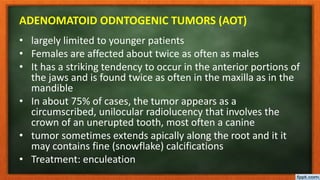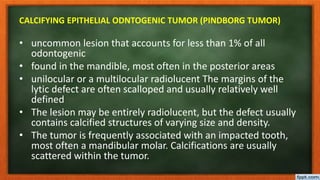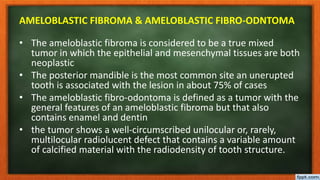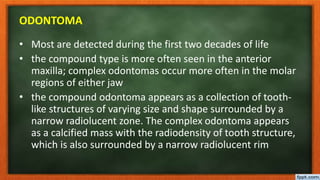LEC 2: ODONTOGENIC TUMORS AND TUMOR LIKE LESIONS OF THE JAW
- 1. ODONTOGENIC TUMORS & TUMOR LIKE LESIONS OF THE JAW Dr. Haydar Munir Salih Alnamer BDS, PhD (Board Certified)
- 2. Definition • neoplasm is a type of abnormal and excessive growth, called neoplasia, of tissue. The growth of a neoplasm is uncoordinated with that of the normal surrounding tissue, and it persists growing abnormally, even if the original trigger is removed his abnormal growth usually (but not always) forms a mass. When it forms a mass, it may be called a tumor.
- 3. Neoplasm • The word is from Ancient Greek neo ("new") and plasma ("formation", "creation").
- 4. Important causes of tumors (swellings) of the jaws • Cysts, predominantly odontogenic cysts • Odontogenic tumors • Giant cell lesions • Fibro-osseous lesions • Primary (non-odontogenic) neoplasms of bone Metastatic neoplasms
- 5. Odontogenic tumour Odontogenic tumors comprise a complex group of lesions of diverse histopathologic types and clinical behavior. Some of these lesions are true neoplasms and may rarely exhibit malignant behavior. Others may represent tumor-like malformations (hamartomas)
- 6. Classification of odontogenic tumors I. Tumors of odontogenic epithelium A. Ameloblastoma 1. Malignant ameloblastoma 2. Ameloblastic carcinoma B. Clear cell odontogenic carcinoma C. Adenomatoid odontogenic tumor D. Calcifying epithelial odontogenic tumor E. Squamous odontogenic tumor
- 7. Classification of Odontogenic Tumors II. Mixed odontogenic tumors A. Ameloblastic fibroma B. Ameloblasticfibro-odontoma C. Ameloblastic fibrosarcoma D. Odontoameloblastoma E. Compound odontoma F. Complex odontoma
- 8. Classification of Odontogenic Tumors III. Tumors of odontogenic ectomesenchyme A. Odontogenic fibroma B. Granular cell odontogenic tumor C. Odontogenic myxoma D. Cementoblastoma
- 9. I. TUMOURS OF ODONTGENIC EPITHELIUM
- 10. AMELOBLASTOMA The ameloblastoma is the most common clinically significant odontogenic tumor. Ameloblastomas are slow-growing, locally invasive tumors They occur in 4 different clinic-radiographic situations: 1. Conventional solid or multicystic (about 86% of all cases) 2. Unicystic (about 13% of all cases) 3. Peripheral (extraosseous) (about 1% of all cases) 4. Desmoplastic type
- 11. AMELOBLASTOMA • is the second most common odontogenic tumor • 80% to 85% of conventional ameloblastomas occur in the mandible • The most typical radiographic feature is a “soap bubble” appearance (when the radiolucent loculations are large) or as being “honeycombed” (when the loculations are small) • Buccal and lingual cortical expansion is frequently present. Resorption of the roots of teeth adjacent to the tumor is common
- 12. AMELOBLASTOMA
- 13. Radiographic features Soap bubbles appearance Honeycombed appearance
- 14. Treatment • The conventional ameloblastoma tends to infiltrate between intact cancellous bone trabeculae at the periphery of the lesion before bone resorption becomes radiographically evident. Therefore, the actual margin of the tumor often extends beyond its apparent radiographic or clinical margin • Solid/multicystic ameloblastomas should be treated radically i.e., by resection with a margin of normal tissue around the tumor. Long-term, even lifelong follow-up is indicated.
- 15. AMELOBLASTOMA
- 16. AMELOBLASTOMA • Ameloblastomas of the posterior maxilla are particularly dangerous because of the difficulty of obtaining an adequate surgical margin around the tumor. Orbital invasion by maxillary ameloblastomas occasionally has been described
- 17. AMELOBLASTOMA
- 18. AMELOBLASTOMA
- 22. CARCINOMA OR CANCER ? • Cancer has always been with us: dinosaur fossils from over 60 million years ago show evidence of malignancy; Egyptian mummies had cancer.
- 23. CANCER = CRAB
- 24. AMELOBLASTIC CARCINOMA/ MALIGNANT AMELOBLASTOMA
- 25. ADENOMATOID ODNTOGENIC TUMORS (AOT) • largely limited to younger patients • Females are affected about twice as often as males • It has a striking tendency to occur in the anterior portions of the jaws and is found twice as often in the maxilla as in the mandible • In about 75% of cases, the tumor appears as a circumscribed, unilocular radiolucency that involves the crown of an unerupted tooth, most often a canine • tumor sometimes extends apically along the root and it it may contains fine (snowflake) calcifications • Treatment: enculeation
- 26. ADENOMATOID ODNTOGENIC TUMORS (AOT)
- 27. CALCIFYING EPITHELIAL ODNTOGENIC TUMOR (PINDBORG TUMOR) • uncommon lesion that accounts for less than 1% of all odontogenic • found in the mandible, most often in the posterior areas • unilocular or a multilocular radiolucent The margins of the lytic defect are often scalloped and usually relatively well defined • The lesion may be entirely radiolucent, but the defect usually contains calcified structures of varying size and density. • The tumor is frequently associated with an impacted tooth, most often a mandibular molar. Calcifications are usually scattered within the tumor.
- 28. CALCIFYING EPITHELIAL ODNTOGENIC TUMOR (PINDBORG TUMOR)
- 29. SQUAMOUS ODNTOGENIC TUMOR (SOT) • Squamous odontogenic tumor is locally aggressive neoplasm • Develop in the periodontal ligament between the roots of vital, erupted permanent teeth. Mobility of teeth, local pain, swelling of the gums, osseous expansion, or mild gingival erythema may be observed • Conservative surgical treatment is considered to be sufficient. Recurrences are rare.
- 30. SQUAMOUS ODNTOGENIC TUMOR (SOT)
- 31. II. MIXED ODNTOGENIC TUMOURS
- 32. AMELOBLASTIC FIBROMA & AMELOBLASTIC FIBRO-ODNTOMA • The ameloblastic fibroma is considered to be a true mixed tumor in which the epithelial and mesenchymal tissues are both neoplastic • The posterior mandible is the most common site an unerupted tooth is associated with the lesion in about 75% of cases • The ameloblastic fibro-odontoma is defined as a tumor with the general features of an ameloblastic fibroma but that also contains enamel and dentin • the tumor shows a well-circumscribed unilocular or, rarely, multilocular radiolucent defect that contains a variable amount of calcified material with the radiodensity of tooth structure.
- 36. ODONTOMA • Odontomas are the most common types of odontogenic tumors. Their prevalence exceeds that of all other odontogenic tumors combined • Odontomas are considered to be developmental anomalies (hamartomas), rather than true neoplasms. When fully developed odontomas consist chiefly of enamel and dentin, with variable amounts of pulp and cementum
- 37. ODONTOMA • Odontomas are further subdivided into compound and complex types. • The compound odontoma is composed of multiple, small tooth-like structures. • The complex odontoma consists of a conglomerate mass of enamel and dentin, which bears no anatomic resemblance to a tooth. In most series, compound odontomas are more frequently diagnosed than complex
- 38. Complex odontoma Compound odontoma
- 39. ODONTOMA • Most are detected during the first two decades of life • the compound type is more often seen in the anterior maxilla; complex odontomas occur more often in the molar regions of either jaw • the compound odontoma appears as a collection of tooth- like structures of varying size and shape surrounded by a narrow radiolucent zone. The complex odontoma appears as a calcified mass with the radiodensity of tooth structure, which is also surrounded by a narrow radiolucent rim
- 40. COMPOUND ODNTOMA COMPLEX ODONTOMA
- 41. ODONTOMA • An un-erupted tooth is frequently associated with the odontoma, and the odontoma prevents eruption of the tooth • Odontomas may erupt!, displace teeth or block their eruption or become involved in cyst formation • Treatment: Odontomas are treated by simple local excision, and the prognosis is excellent.
- 42. ERUPTED ODONTOMA
- 43. ODONTOMA
- 44. III. TUMORS OF ODONTOGENIC ECTOMESENCHYME
- 45. MYXOMA • mandible is involved more commonly than the maxilla • Larger lesions are often associated with a painless expansion of the involved bone • may show a “soap bubble” radiolucent pattern, which is indistinguishable from that seen in ameloblastoma • For larger lesions, more extensive resection may be required because myxomas are not encapsulated and tend to infiltrate the surrounding bone
- 46. MYXOMA
- 47. MYXOMA
- 48. MYXOMA
- 49. CEMENTOBLASTOMA • Cementoblastoma is an odontogenic neoplasm of cementoblasts • Almost 50% involve the first permanent molar. Cementoblastomas rarely affect deciduous teeth • two thirds of reported patients signs of locally aggressive behavior may be observed, including bony expansion, cortical erosion, displacement of adjacent teeth, envelopment of multiple adjacent teeth, maxillary sinus involvement, and infiltration into the pulp chamber and root canals
- 50. CEMENTOBLASTOMA • Radiographic features: the tumor appears as a radiopaque mass that is fused to one or more tooth roots and is surrounded by a thin radiolucent rim • Treatment: usually consists of surgical extraction of the tooth together with the attached calcified mass.
- 51. CEMENTOBLASTOMA
- 52. CEMENTOBLASTOMA
- 53. OTHER TUMOURS AND DYSPLASIAS OF CEMENTUM • CEMENTO-OSSEOUS DYPLASIAS These are non-neoplastic proliferations. They are of periodontal ligament origin and all the variants involve the same pathological processes and differ mainly in their extent and radiographic appearances. Treatment is not indicated except rarely for cosmetic reasons

























































